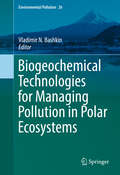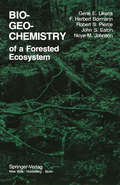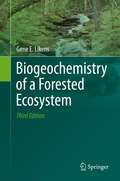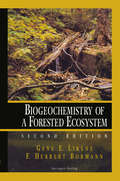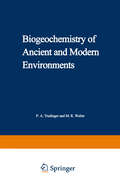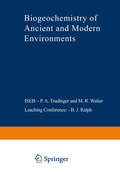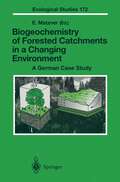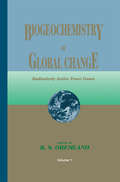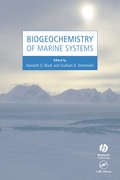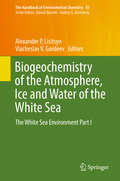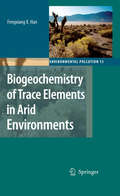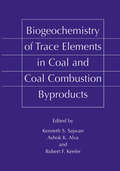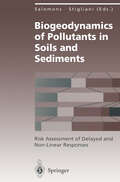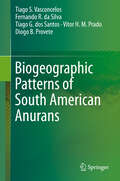- Table View
- List View
Biogeochemical Processes of Biogenic Elements in China Marginal Seas (Advanced Topics in Science and Technology in China)
by Jinming Song"Biogeochemical Processes of Biogenic Elements in China Marginal Seas" is the first monograph dedicated to this topic. The book mainly presents the latest research achievements of China's national research projects about the biogenic element cycling processes in China marginal seas starting in 1999. By describing the biogeochemical processes of China marginal seas, including the Bohai Sea, the Yellow Sea, the East China Sea, and the South China Sea, it covers almost all kinds of typical ecosystems' regional responses to global oceanic changes of the estuarine ecosystem, the continental shelf ecosystem, the upwelling ecosystem, the coral reef ecosystem, and the mangrove ecosystem. It will be of great interest to scientists and researchers in marine science. Dr. Jinming Song is a professor at Institute of Oceanology, Chinese Academy of Sciences.
Biogeochemical Technologies for Managing Pollution in Polar Ecosystems (Environmental Pollution #26)
by Vladimir N. BashkinThis edited book is devoted to environmental risk management in gas industry impacted polar ecosystems of Russia, one of the hottest topics of modern environmental science. The contributions from experts cover topics that shed new light on the impacts of oil and natural gas production on arctic ecosystems in the country as well as biogeochemical engineering technologies to manage pollution in these areas. Readers will also discover new insights on potential ecological indicators for assessing geo-environmental risks of these impacted ecosystems, and climate modeling in polar areas. The book has interdisciplinary appeal, and specialists and practitioners in environmental sciences, ecology, biogeochemistry and those within the energy sector who are interested in understanding ecosystems affected by anthropogenic impacts in severe climatic conditions will find it particularly engaging. Through this book, readers will learn more about biogeochemical cycling through food chains and specific reactions of biota to environmental pollution in extreme environments through the lens of experts.
Biogeochemical Transformations in the Baltic Sea: Observations Through Carbon Dioxide Glasses (Springer Oceanography)
by Bernd Schneider Jens Daniel MüllerThis book provides a comprehensive review of the biogeochemistry in the Baltic Sea. It is based on the fact that biogeochemical processes that are relevant for the ecological state of the Baltic Sea (and other sea areas), are all in some way related to the production and mineralization of organic matter (biomass) and thus are associated with the consumption or release of CO2. The significant progress with regard to our chemical analytical capabilities concerning the marine CO2 system has facilitated new approaches to study the Baltic Sea biogeochemistry, in particular with regard to a quantitative process understanding. To demonstrate this, the authors present the fundamentals of the marine CO2 system in a theoretically sound, but still intelligible way. This is followed by a comprehensive presentation of our current knowledge about the CO2 system in the Baltic Sea and the implications for our understanding of biogeochemical processes such as production/mineralization of organic matter and the stoichiometry involved, nitrogen fixation, denitrification, and phosphate transformations at varying redox conditions. Finally, the CO2 gas exchange balance and related problems such as acidification are addressed.
Biogeochemistry of a Forested Ecosystem
by G. E. Likens F. H. Bormann R. S. Pierce J. S. Eaton N. M. JohnsonAbout 15 years ago we began the Hubbard Brook Ecosys tem Study with the development of an ecosystem model and the conception of a method whereby some major parameters of the model could be directly measured under field conditions. The method, called "the small watershed technique," allowed measurement of input and output of chemicals and the construction of ecosystem nutrient bud gets. Although the Hubbard Brook study of nutrient cycling originated with ideas developed by F. H. Bormann and G. E. Likens, its early growth was aided by the remaining authors of this volume-Robert Pierce, forest hydrologist; Noye Johnson, geochemist; and John Eaton, forest ecologist. Donald W. Fisher of the United States Geological Survey also cooperated in the early phases of the project and provided numerous data on the chemistry of precipitation and stream water. Particular credit is due the United States Forest Service, whose scientists chose the Hubbard Brook Valley as a hydrologic study site, selected particular watersheds for intensive measurement, carried out a variety of basic hydrologic studies, and in general cooperated with us in many ways to make the Hubbard Brook Ecosystem Study a reality. The initial part of the ecosystem study was concerned primarily with nutrient flux and cycling and it was done slowly and deliberately. The entire effort during the first few years of study was carried forward by three of us at vi Preface Dartmouth College with the cooperation of the United States Forest Service.
Biogeochemistry of a Forested Ecosystem
by Gene E. LikensThe goal of this Third Edition is to update long-term data presented in earlier editions and to generate new syntheses and conclusions about the biogeochemistry of the Hubbard Brook Valley based on these longer-term data. There have been many changes, revelations, and exciting new insights generated from the longer data records. For example, the impact of acid rain peaked during the period of the HBES and is now declining. The longer-term data also posed challenges in that very marked changes in fluxes occurred in some components, such as hydrogen ion and sulfate deposition, calcium and nitrate export in stream water and biomass accumulation, during the almost 50 years of record. Thus, presenting “mean” or “average” conditions for many components for such a long period, when change was so prominent, do not make sense. In some cases, pentads or decades of time are compared to show these changes in a more smoothed and rational way for this long period. In some cases, a single period, often during periods of rapid change, such as acidification, is used to illustrate the main point(s). And, for some elements a unique mass balance approach, allowing the calculation of the Net Ecosystem Flux (NEF), is shown on an annual basis throughout the study.
Biogeochemistry of a Forested Ecosystem
by Gene E. Likens F.Herbert BormannWhen we originally published Biogeochemistry of a Forested Ecosystem in 1977, the Hubbard Brook Ecosystem Study (HBES) had been in existence for 14 years, and we included data through 1974, or a biogeo chemical record of 11 years. Now our continuous, long-term biogeo chemical records cover more than 31 years, and there have been many changes. The most notable change, however, is that three of our coauthors on the original volume are now deceased. They are deeply missed in so many ways. In spite of the longer records, different trends, and new insights, we believe that the basic concepts and approaches we presented in 1977 represent the most valuable contribution of the original edition. They are still valid and useful, particularly for an introductory study of, or course in, biogeochemistry. Our goal in this revision is to preserve these fea tures, correct errors, and revise or eliminate misleading or ambiguous short-term data (11 years!), while maintaining approximately the original length and the modest cost.
Biogeochemistry of a Subalpine Ecosystem: Loch Vale Watershed (Ecological Studies #90)
by M. A. Arthur A. S. Dennings M. A. Harris M. A. Mast D. M. McKnight P. McLaughlin B. D. Rosenlund S. A. Spaulding P. M. WalthallRocky Mountain National Park was established in 1915, one year before the creation of the National Park Service. The mandate of the National Park Service is to preserve and protect areas of exquisite beauty and cultural value for the benefit and enjoyment of future generations. National parks mean many things to many people, and, in often stirring words, a National Parks and Conservation Association report states the National Park System is a magnificent and uniquely American gift to the American people and the world. In the early years of the Service, park superintendents actively promoted and developed parks to accommodate visitors. Then, as now, parks represented a democratic ideal, that even the greatest treasures should be available to all. Seventy five years ago, however, park managers saw little need for active management of natural resources, unless it was to enhance visitors' experience. And few managers saw the need for a stable and independent research program on which to base management decisions. Thus began a legacy of erratic, often passive, resource management based more on politics and in-house studies than on validated scientific informa tion. The world is a different place than it was 75 years ago. Human population growth, changes in land use, and ever more sophisticated technology affect the very fabric of life on Earth. As local-, regional-, and global-scale changes occur from human tampering with the environment, the integrity of natural ecosystems is threatened worldwide.
Biogeochemistry of Ancient and Modern Environments: Proceedings of the Fourth International Symposium on Environmental Biogeochemistry (ISEB) and, Conference on Biogeochemistry in Relation to the Mining Industry and Environmental Pollution (Leaching Conference), held in Canberra, Australia, 26 August – 4 September 1979
by P. A. Trudinger M. R. Walter B. J. RalphThis volume contains a selection of papers presented to the Fourth Internation~l Symposium on Environmental Biogeochemistry (ISEB), and a conference on Biogeochemistry in Relation to Mining Industry and Environmental Pollution (Leaching Conference), held in Canberra, Aust ralia on August 26-31 and September 3-4, 1979, respectively. The ISEB were established to provide "a forum for uninhibited exchange of information and ideas among the biological, chemical, atmospheric and geolorical scientists working in the common area of biogeochemistry, encompassing soil and other earth sciences as well as the hydrosphere and atmosphere", By linking the fourth ISEB with the Leachin~ Conference the scope of discussions was extended to encompass the application of biogeochemical processes to the mining industry. This wide-ranging philosophy is reflected in the breadth and diversity of the subjects covered in this book. The published papers are expanded versions of those presented at the meetings. They have all been scrutinized by at least one referee in addition to the editors. About 20% of the contributions to the meetings are not included, either because authors did not wish to publish or because the papers were not accepted by the editors.
Biogeochemistry of Ancient and Modern Environments: Proceedings of the Fourth International Symposium on Environmental Biogeochemistry (ISEB) and, Conference on Biogeochemistry in Relation to the Mining Industry and Environmental Pollution (Leaching Conference), held in Canberra, Australia, 26 August – 4 September 1979
by P. A. Trudinger M. R. Walter B. J. RalphThis volume contains a selection of papers presented to the Fourth International Symposium on Environmental Biogeochemistry (ISEB), and a conference on Biogeochemistry in Relation to Mining Industry and Environmental Pollution (Leaching Conferenc~, held in Canberra, Aust ralia on August 26-31 and September 3-4, 1979, respectively. The ISEB were established to provide "a forum for uninhibited exchange of information and ideas among the biological, chemical, atmospheric and geolopical scientists working in the common area of biogeochemistry, encompassing soil and other earth sciences as weIL as the hydrosphere and atmosphere", By linking the fourth ISEB with the Leachinp Conference the scop.e of discussions was extended to encompass the application of biogeochemical processes to the mining industry. This wide-ranging philosophy is reflected in the breadth and diversity of the subjects covered in this book. The published papers are expanded versions of those presented at the meetings. They have all been scrutinized by at least one referee in addition to the editors. About 20% of the contributions to the meetings are not included, either because authors did not wish to publish or because the papers were not accepted by the editors.
Biogeochemistry of Forested Catchments in a Changing Environment: A German Case Study (Ecological Studies #172)
by Egbert MatznerForest ecosystems represent a major type ofland use in Germanyand in Europe. They provide a number of functions, or ecosystem services, beneficial to humans, namely biomass production, regulation of the water- and energy cyde, C and N sequestration, erosion control, recreation, and they act as habitat for numerous species. The stability of forest ecosystems in Europe as influenced by the deposition of air pollutants has been a matter of debate for more than 20 years. Besides atmospheric deposition, other environmental conditions affecting forest ecosystems, such as temperature, CO content of the atmosphere 2 and precipitation, have significantly changed in the past and continue to change in the future. Quantifying and predicting the effects of these changes on ecosys tem functioning are achallenge to ecosystem research and also a requirement to establish sustainable use of forest ecosystems in the future. This book summarizes results of long-term, interdisciplinary ecosystem research conducted in two forested catchments and coordinated at the Bayreuth Institute of Terrestrial Ecosystem Research (BITÖK), University of Bayreuth, Germany. It does not aim to summarize all the research of BITÖ K in the past decade, which would go far beyond the studies in these two catch ments. Instead, we concentrate here on the long-term developments in the biogeochemistry of carbon and mineral elements and on the water cyde, at both the plot and the catchment scale.
Biogeochemistry of Global Change: Radiatively Active Trace Gases Selected Papers from the Tenth International Symposium on Environmental Biogeochemistry, San Francisco, August 19–24, 1991
by Ronald S. OremlandCertain trace gases in the atmosphere are able to absorb electromagnetic energy from the reflection of solar radiation from the Earth's surface. These gases have been increasing steadily and there is concern that they will change global climatic conditions by warming the atmosphere--the so-called ``greenhouse effect.'' Many of these gases originate from biological systems. The Biogeochemistry of Global Change discusses the role of radiative trace gases in this process. The disciplines covered in the book include microbiology, geochemistry, atmospheric chemistry, plant physiology, oceanography and limnology, and soil science. This diversity allows for cross-fertilization, achieving a better understanding of the complex mechanisms for biological and chemical formation, the destruction of trace gases, and the manipulation of ecosystems. Some of the topics covered include: biological mechanisms of formation and destruction of various ``greenhouse'' gases (such as methane, nitrous oxide, carbon dioxide, dimethylsulfide, and chlorofluorocarbons); the outward and consumptive flux of trace gases from marine and terrestrial systems (including anthropogenic sources); global trace gas modeling studies; the atmospheric physical and chemical reactions of trace gases; and the environmental significance of various trace gases in ancient and current atmospheres. The Biogeochemistry of Global Change provides both reviews and primary source material for active researchers in this field and for microbiologists and atmospheric chemists.
Biogeochemistry of Marine Systems (Biological Sciences Series)
by Kenneth D. Black Graham B. ShimmieldMarine systems vary in their sensitivities to perturbation. Perturbation may be insidious – such as increasing eutrophication of coastal areas – or it may be dramatic – such as a response to an oil spillage or some other accident. Climate change may occur incrementally or it may be abrupt, and ecosystem resilience is likely to be a complex function of the interactions of those assemblages or species mediating key biogeochemical processes. Biogeochemistry of Marine Systems considers issues of marine system resilience, focusing on a range of marine systems that exemplify major global province types but are also interesting and topical in their own right, on account of their sensitivity to natural or anthropogenic change or their importance as ecological service providers. Authors concentrate on advances of the last decade.
Biogeochemistry of Marine Systems
by Kenneth D. Black Graham B. ShimmieldMarine systems vary in their sensitivities to perturbation. Perturbation may be insidious - such as increasing eutrophication of coastal areas - or it may be dramatic - such as a response to an oil spill or some other accident. Climate change may occur incrementally or it may be abrupt, and ecosystem resilience is likely to be a complex function of the interactions of the factors and species mediating key biogeochemical processes.Biogeochemistry of Marine Systems considers issues of marine system resilience, focusing on a range of marine systems that exemplify major global province types. Each system is interesting in its own right, on account of its sensitivity to natural or anthropogenic change or its importance as an ecological service provider. Each contributing author concentrates on advances of the last decade.This prime reference source for marine biogeochemists, marine ecologists, and global systems scientists provides a strong foundation for the study of the multiple marine systems undergoing change because of natural biochemical or anthropogenic factors.
Biogeochemistry of Marine Systems
by KENNETH D. BLACK; GRAHAM B. SHIMMIELDMarine systems vary in their sensitivities to perturbation. Perturbation may be insidious - such as increasing eutrophication of coastal areas - or it may be dramatic - such as a response to an oil spill or some other accident. Climate change may occur incrementally or it may be abrupt, and ecosystem resilience is likely to be a complex function of the interactions of the factors and species mediating key biogeochemical processes.Biogeochemistry of Marine Systems considers issues of marine system resilience, focusing on a range of marine systems that exemplify major global province types. Each system is interesting in its own right, on account of its sensitivity to natural or anthropogenic change or its importance as an ecological service provider. Each contributing author concentrates on advances of the last decade.This prime reference source for marine biogeochemists, marine ecologists, and global systems scientists provides a strong foundation for the study of the multiple marine systems undergoing change because of natural biochemical or anthropogenic factors.
The Biogeochemistry of Submerged Soils
by Guy KirkSubmerged soils and the wetlands they support are of huge practical importance: in global element cycles, as centres of biodiversity, in global food production. They are also uniquely interesting scientifically because of their peculiar biogeochemistry and the adaptations of plants and microbes to it. This book describes the physical, chemical and biological processes operating in submerged soils and governing their properties. It describes the transport processes controlling the fluxes of gases and solutes through the soil; the interchange of solutes between solid, liquid and gas phases; reduction and oxidation processes; biological processes in the soil and overlying water; and processes in the roots and rhizospheres of wetland plants. The dynamics of nutrients, toxins, pollutants and trace gases are then discussed in terms of these processes and in relation to wetland productivity and global element cycles. Written by a renowned expert in the field, this work will be invaluable to earth, environmental and agricultural scientists concerned with natural or man-made wetlands, and to advanced undergraduate and graduate studen ts of these topics.
The Biogeochemistry of the Amazon Basin
by Michael E. McClain Reynaldo Victoria Jeffrey E. RicheyWith a complex assemblage of largely intact ecosystems that support the earth's greatest diversity of life, the Amazon basin is a focal point of international scientific interest. And, as development and colonization schemes transform the landscape in increasing measure, scientists from around the world are directing attention to questions of regional and global significance. Some of these qustions are: What are the fluxes of greenhouse gases across the atmospheric interface of ecosystems? How mush carbon is stored in the biomass and soils of the basin? How are elements from the land transferred to the basin's surface waters? What is the sum of elements transferred from land to ocean, and what is its marine "fate"? This book of original chapters by experts in chemical and biological oceanography, tropical agronomy and biology, and the atmospheric sciences will address these and other important questions, with the aim of synthesizing the current knowledge of biochemical processes operating within and between the various ecosystems in the Amazon basin.
Biogeochemistry of the Atmosphere, Ice and Water of the White Sea: The White Sea Environment Part I (The Handbook of Environmental Chemistry #81)
by Alexander P. Lisitsyn Viacheslav V. GordeevThis book is devoted to the biogeochemical environment of the White Sea, an inland sea in the Northwestern region of Russia. It provides a comprehensive review and discusses the latest research findings on the oceanology, sedimentology and biogeochemistry of the White Sea water column. The topics discussed include the regulation of the physico-geographical conditions in the White Sea basin; dispersed sedimentary substance of the atmosphere and the cryosphere; the geochemical peculiarities of the river discharge into the White Sea; and the phyto- and zooplankton activities in the White Sea. Taking the biggest river in the White Sea basin as an example, the authors closely examine the deposition of suspended particulate matter, the biogeochemical behaviour of dissolved and suspended forms of organic material and the significant group of chemical elements in the river-sea mixing zone of the Severnaya Dvina River. The book ends with a summary of the key conclusions and recommendations. Together with the companion volume Sedimentation Processes in the White Sea: The White Sea Environment Part II, it offers an essential source of information for postgraduate students, researchers and stakeholders alike.
Biogeochemistry of Trace Elements in Arid Environments (Environmental Pollution #13)
by Fengxiang X. HanThis book offers comprehensive coverage of trace elements in arid zone regions. It begins by introducing the nature and properties of arid zone soil, followed by coverage of the major aspects of the trace elements and heavy metals of most concern in the world’s arid and semi-arid soils. A comprehensive, focused case study on transfer fluxes of trace elements in Israeli arid soils is used to illustrate the themes presented in the book.
Biogeochemistry of Trace Elements in Coal and Coal Combustion Byproducts
by Robert F. Keefer Ashok K. Alva Kenneth S. SajwanThe research papers in this book present current knowledge of the sources, pathways, behavior, and effects of trace elements in soils, waters, plants, and animals. It is of interest to a variety of readers, including public health and environmental professionals, consultants, and academicians.
Biogeochemistry of Wetlands: Science and Applications
by K. Ramesh Reddy Ronald D. DeLaune Patrick W. InglettThe globally important nature of wetland ecosystems has led to their increased protection and restoration as well as their use in engineered systems. Underpinning the beneficial functions of wetlands are a unique suite of physical, chemical, and biological processes that regulate elemental cycling in soils and the water column. This book provides an in-depth coverage of these wetland biogeochemical processes related to the cycling of macroelements including carbon, nitrogen, phosphorus, and sulfur, secondary and trace elements, and toxic organic compounds. In this synthesis, the authors combine more than 100 years of experience studying wetlands and biogeochemistry to look inside the black box of elemental transformations in wetland ecosystems. This new edition is updated throughout to include more topics and provide an integrated view of the coupled nature of biogeochemical cycles in wetland systems. The influence of the elemental cycles is discussed at a range of scales in the context of environmental change including climate, sea level rise, and water quality. Frequent examples of key methods and major case studies are also included to help the reader extend the basic theories for application in their own system. Some of the major topics discussed are: Flooded soil and sediment characteristics Aerobic-anaerobic interfaces Redox chemistry in flooded soil and sediment systems Anaerobic microbial metabolism Plant adaptations to reducing conditions Regulators of organic matter decomposition and accretion Major nutrient sources and sinks Greenhouse gas production and emission Elemental flux processes Remediation of contaminated soils and sediments Coupled C-N-P-S processes Consequences of environmental change in wetlands The book provides the foundation for a basic understanding of key biogeochemical processes and its applications to solve real world problems. It is detailed, but also assists the reader with box inserts, artfully designed diagrams, and summary tables all supported by numerous current references. This book is an excellent resource for senior undergraduates and graduate students studying ecosystem biogeochemistry with a focus in wetlands and aquatic systems.
Biogeochemistry of Wetlands: Science and Applications
by K. Ramesh Reddy Ronald D. DeLaune Patrick W. InglettThe globally important nature of wetland ecosystems has led to their increased protection and restoration as well as their use in engineered systems. Underpinning the beneficial functions of wetlands are a unique suite of physical, chemical, and biological processes that regulate elemental cycling in soils and the water column. This book provides an in-depth coverage of these wetland biogeochemical processes related to the cycling of macroelements including carbon, nitrogen, phosphorus, and sulfur, secondary and trace elements, and toxic organic compounds. In this synthesis, the authors combine more than 100 years of experience studying wetlands and biogeochemistry to look inside the black box of elemental transformations in wetland ecosystems. This new edition is updated throughout to include more topics and provide an integrated view of the coupled nature of biogeochemical cycles in wetland systems. The influence of the elemental cycles is discussed at a range of scales in the context of environmental change including climate, sea level rise, and water quality. Frequent examples of key methods and major case studies are also included to help the reader extend the basic theories for application in their own system. Some of the major topics discussed are: Flooded soil and sediment characteristics Aerobic-anaerobic interfaces Redox chemistry in flooded soil and sediment systems Anaerobic microbial metabolism Plant adaptations to reducing conditions Regulators of organic matter decomposition and accretion Major nutrient sources and sinks Greenhouse gas production and emission Elemental flux processes Remediation of contaminated soils and sediments Coupled C-N-P-S processes Consequences of environmental change in wetlands The book provides the foundation for a basic understanding of key biogeochemical processes and its applications to solve real world problems. It is detailed, but also assists the reader with box inserts, artfully designed diagrams, and summary tables all supported by numerous current references. This book is an excellent resource for senior undergraduates and graduate students studying ecosystem biogeochemistry with a focus in wetlands and aquatic systems.
Biogeodynamics of Pollutants in Soils and Sediments: Risk Assessment of Delayed and Non-Linear Responses (Environmental Science and Engineering)
by William M. Stigliani WimSalomonsIn the USA, Western and Central Europe, there are many large-scale polluted sites that are too large to be cleaned up economically with available technologies. The pollution is caused by heavy industries to soils and sediments in waterways and reservoirs. Since these areas are expected to remain polluted for many years, it is necessary to take a long-term view to insure that the capacity to retain the contaminants is not diminished and to understand the potential for large-scale contaminant mobilization at these sites triggered by changing environmental conditions. This book provides information for predicting long-term changes and making risk assessments and describes the approach of geochemical engineering to handling large-scale polluted sites.
Biogeogens and Human Health (SpringerBriefs in Public Health)
by Niraj KumarHealth of the people is the most important indicator of the development of a nation. Health is a state of complete physical, mental and social well being and not merely the absence of disease or infirmity (as defined by WHO). The state of health of an individual or population depends upon complex interaction of the physical, biological, political and social domains. The environment affects the human health in a big way. People tend to be most susceptible to illness when physically or mentally stressed. Stress, energy and immunity form a closely knit network. Through his experimental findings, the author has brought out this intricate concept of interdependence of biotic (living) and abiotic (non-living) factors in an ecosystem, resulting in an impact on human health, in an explicitly marvelous manner. As a result, a new word “Biogeogens” has been coined, “bio” for living (biotic) , “geo” for non-living (abiotic/geographical/climatic/environment) and “gens” for the interactive proceeds of the two. The content included herein is directly concerned with the societal health and gives a clue to many socio-psycho health problems presently not handled with care. It also defines a multidimensional approach for dealing with many psychosomatic and health problems.
Biogeographic Patterns of South American Anurans
by Tiago S. Vasconcelos Fernando R. da Silva Tiago G. dos Santos Vitor H. Prado Diogo B. ProveteThis book analyzes different facets of anuran amphibian distribution in South America. We integrate alternative biological metrics employing cutting-edge methods to understand the dynamic processes underlying species distribution patterns. By using the modern biogeographic toolbox, we explore how richness gradients, phylogenetic diversity, functional diversity, and range size/endemism distribution of amphibians vary along the continent. Moreover, we present a robust proposal for priority areas for conservation of anurans in South America that maximizes representativeness of distinct biodiversity facets.
A Biogeographical Analysis of the Chihuahuan Desert through its Herpetofauna (Biogeographica #9)
by D.J. MorafkaThe Mexican Plateau, in its magnificent dimensions and material wealth, stood among the first and perhaps most alluring discoveries of European explorers. Bur ied deeper in the verbal histories of a now vanquished people, the American Indians, must be the primordial human awareness of the inverted complex triangle that dominates the Mexican topography, climate and biota. It always has been viewed by man as a source of wealth and a center of authority. The plateau is the pillar upon which all Mexican conquerors have erected their capitols, tilled their crops and mined for their treasure, and from which they dispersed the forces of their authority. Ironically, the same size and diversity that give the plateau its value, also make it an immense barrier. Its broad desert and three to five thousand meter high crests constitute severe obstacles in the path of North American man. What has just been said of mankind in general, can be applied to the biologist in particular. He too has termed the goliath southern plateau as the crucible of the arid biotas of the continent (i. e. , 'Madro-Tertiary'). The biologist found the plateau to be a region of tremendous richness and diversity. But he also has been inhibited both physically and intellectually by its high mountain and vast desert barriers.

